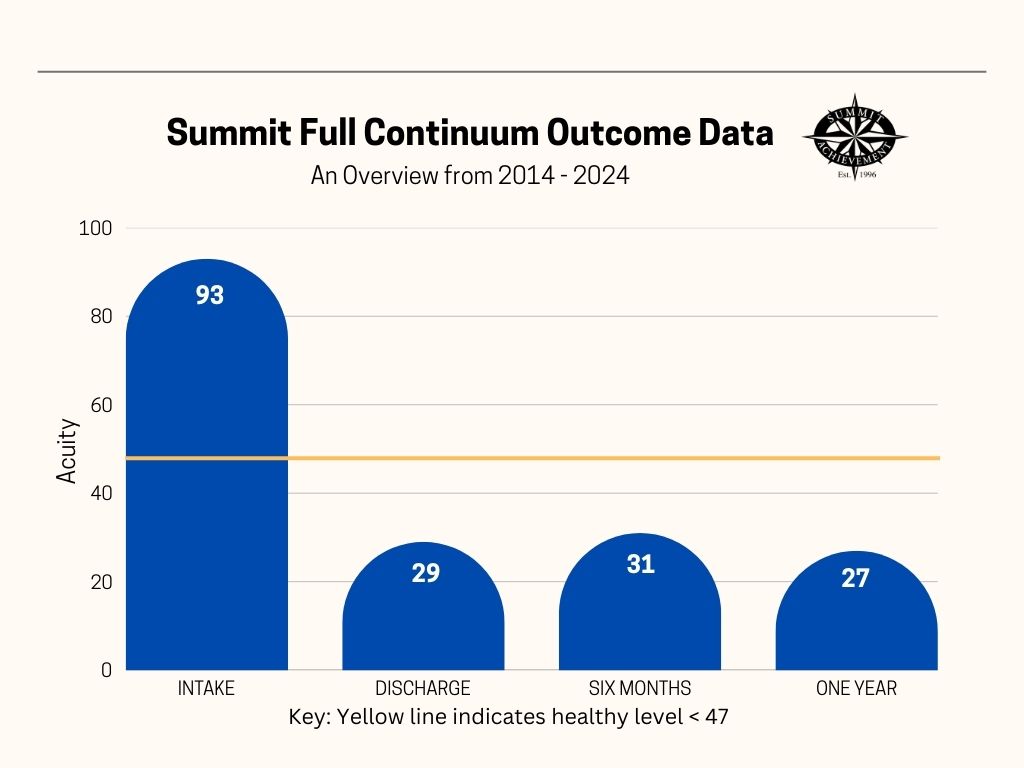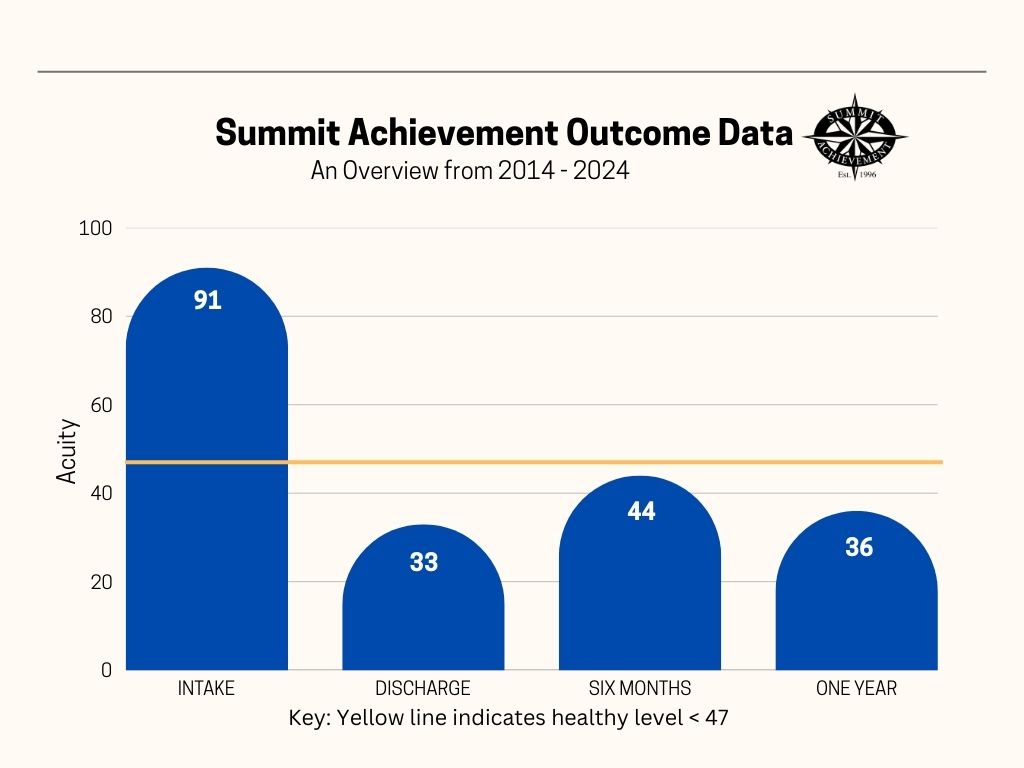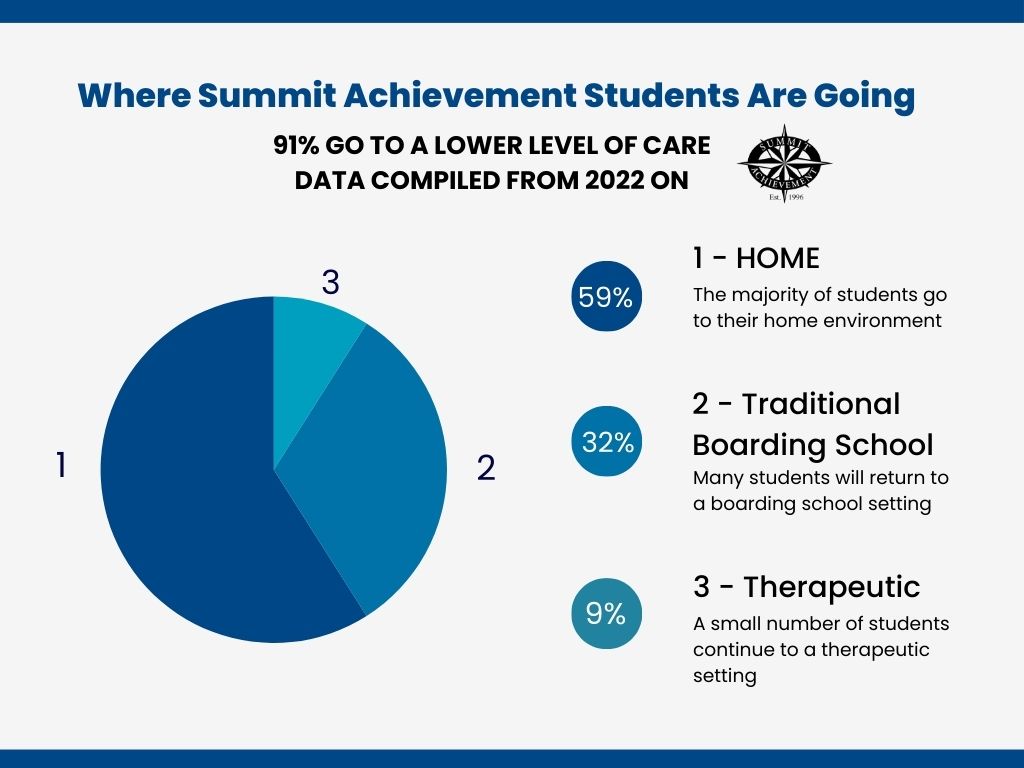Why Outcome Data Matters
When faced with mental health challenges, parents, guardians, and referring professionals often turn to residential treatment programs for help. Summit Achievement, a licensed residential treatment center and an accredited school, offers intensive support in a structured, therapeutic environment — but how can families and referral partners know if Summit Achievement is truly effective?
The answer is outcome data.
What is Outcome Data? Outcome data refers to the measurable results a program tracks to assess how well it is helping its residents. This can include mental health symptoms (e.g., depression, anxiety, trauma-related symptoms), behavioral changes, and family functioning.
Why Outcome Data Is Essential
1. Demonstrates Program Effectiveness
Without data, it’s nearly impossible to prove that a residential treatment program is making a real difference in the lives of the adolescents it serves. Tracking outcomes gives programs tangible evidence that their therapeutic interventions work — or highlights where they need to improve.
2. Supports Continuous Improvement
Collecting and analyzing outcome data allows programs to identify trends and patterns over time. Are certain interventions consistently leading to better results? Outcome data empowers clinical teams to refine and enhance their approach for better results.
3. Builds Trust with Families and referral partners
Parents placing their child in a residential treatment program are making a significant emotional and financial commitment. Outcome data provides transparency and assurance that the program is not just supportive, but evidence-based. It also helps referring professionals understand the program’s value.
4. Aligns with Accreditation and Licensing Standards
Many accrediting bodies now require outcome tracking as part of their standards. Demonstrating data-informed care is essential for programs to maintain their standing and credibility in the field.
What Good Outcome Tracking Looks Like
Effective programs don’t just collect data — they make it meaningful. This means:
- Using validated, standardized assessment tools
- Ensuring data is collected consistently and ethically
- Sharing insights transparently with families and staff
- Following up after discharge to assess long-term outcomes
A Culture of Accountability and Hope Ultimately, outcome data reflects Summit Achievements commitment to accountability, growth, and — most importantly — hope. It shows that healing isn’t just possible, it’s measurable. When residential treatment programs prioritize outcome tracking, they signal to families that they are serious about delivering lasting change, not just temporary solutions.
Now that you know WHY outcome data is important, here is Summit Achievement’s Ten Year Outcome Data: 2014 – 2024
The below graphs represent ten (10) years of data collected from students and parents on the Youth Outcome Questionnaire (Y-OQ) to assess overall mental health upon enrollment (Intake), upon leaving the program (Discharge), six months (6 mos.) post-discharge, and one year (1 yr) post-discharge.


How Is The Data Derived?
- This data is derived from completing the Youth Outcome Questionnaire, a 64-question tool given to parents/caregivers and students.
- Only clients that had complete data sets at intake, discharge, six months, and/or one year were included.
- Several hundred complete data sets were used to calculate both Achievement and full-continuum results (Achievement + Traverse).
What Is The Yellow Line?
- The yellow horizontal line in each graph distinguishes a clinical “healthy” level of functioning
- Below the yellow line: Healthy level of functioning
- Above the yellow line: Unhealthy level of functioning
- Note: 13 points represents a clinically significant change
Our Data Shows: Summit students drop between 58 (Achievement alone) and 64 (Summit Achievement Continuum) points during their stay and maintain significant change six months and one year after discharge.
Overwhelmingly, clients who participate in our Continuum – Both Achievement and Traverse – make significant growth in managing their mental health.
Clients who do the full-continuum perform better at discharge, 6 months post-discharge, and 1 year post-discharge compared to clients who just do Achievement.
Where are Summit Students Going?
The chart below speaks for itself – 91% of students who do the full continuum of care at Summit Achievement (that is both Achievement and Traverse) are going to a LOWER LEVEL OF CARE.
59% of students are going to their home environment
32% of students are going to a traditional boarding school

If your teenager is struggling with their mental health or difficulty within the family system and you are considering treatment options, perhaps Summit Achievement could be right for your family. Reach out to Admissions today. If you would like to access more data points, please reach out to barb@summitachievement.com